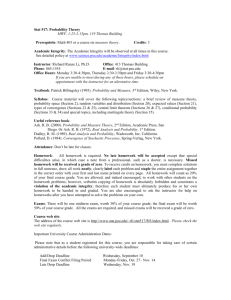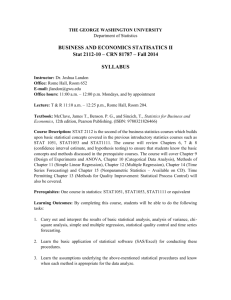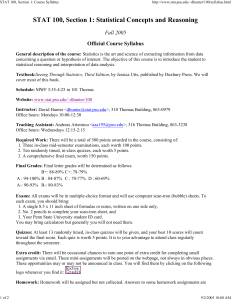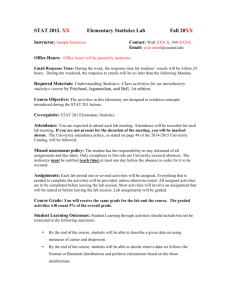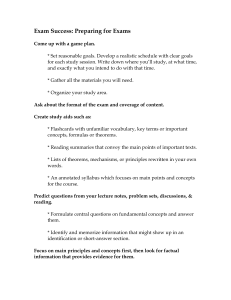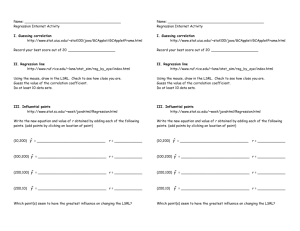Stat 511 - Penn State Department of Statistics
advertisement
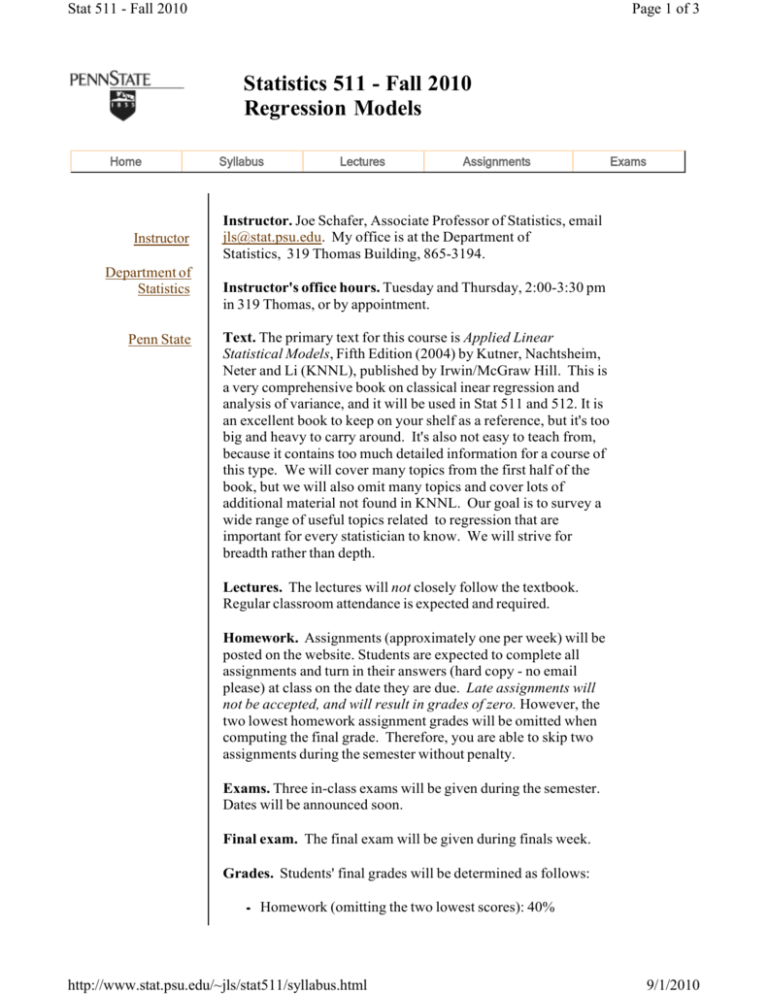
Stat 511 - Fall 2010 Page 1 of 3 Statistics 511 - Fall 2010 Regression Models Home Instructor Department of Statistics Penn State Syllabus Lectures Assignments Exams Instructor. Joe Schafer, Associate Professor of Statistics, email jls@stat.psu.edu. My office is at the Department of Statistics, 319 Thomas Building, 865-3194. Instructor's office hours. Tuesday and Thursday, 2:00-3:30 pm in 319 Thomas, or by appointment. Text. The primary text for this course is Applied Linear Statistical Models, Fifth Edition (2004) by Kutner, Nachtsheim, Neter and Li (KNNL), published by Irwin/McGraw Hill. This is a very comprehensive book on classical inear regression and analysis of variance, and it will be used in Stat 511 and 512. It is an excellent book to keep on your shelf as a reference, but it's too big and heavy to carry around. It's also not easy to teach from, because it contains too much detailed information for a course of this type. We will cover many topics from the first half of the book, but we will also omit many topics and cover lots of additional material not found in KNNL. Our goal is to survey a wide range of useful topics related to regression that are important for every statistician to know. We will strive for breadth rather than depth. Lectures. The lectures will not closely follow the textbook. Regular classroom attendance is expected and required. Homework. Assignments (approximately one per week) will be posted on the website. Students are expected to complete all assignments and turn in their answers (hard copy - no email please) at class on the date they are due. Late assignments will not be accepted, and will result in grades of zero. However, the two lowest homework assignment grades will be omitted when computing the final grade. Therefore, you are able to skip two assignments during the semester without penalty. Exams. Three in-class exams will be given during the semester. Dates will be announced soon. Final exam. The final exam will be given during finals week. Grades. Students' final grades will be determined as follows: Homework (omitting the two lowest scores): 40% http://www.stat.psu.edu/~jls/stat511/syllabus.html 9/1/2010 Stat 511 - Fall 2010 Page 2 of 3 Three in-class exams: 30% Final exam: 30% Collaborative work. Throughout this course, students are encouraged to work together--for example, to help one another with computer issues, to share class notes and discuss the material, etc. On homework assignments, a reasonable amount of collaboration is allowed. Each student, however, must turn in his or her own written work which reflects his or her own individual understanding of the material. Because this is a graduate course, the students will be assumed to have sufficient motivation and maturity to come to their own understanding of the material without a strict working-alone policy. Collaboration during in-class exams is not allowed. Computing. Data will be analyzed using R. This is free package for UNIX, Windows and MacOS available at http://www.rproject.org/. If you are not familiar with R, a list of resources is available at the R project website. Also check out Paul Johnson's R tips page. On occasion, we will also use a few procedures in SAS. Prerequisites. This course is intended primarily for graduate students in the Department of Statistics, but qualified students from other programs are welcome to attend. This is a course in data analysis, not mathematical statistics, so students need not be mathematically sophisticated to do well in this course. Certain basic mathematical skills will be necessary, however, inasmuch as they constitute the language of applied statistics. We will assume basic familiarity with basic statistics (histograms, t-tests, confidence intervals, correlation, hypothesis testing, p-values, etc.), elementary probability theory (axioms of probability, random variables, expectation, variance, binomial distribution, normal distribution, etc.), a little bit of calculus (mostly derivatives and partial derivatives), and matrix algebra (multiplication, inversion, determinants, etc.). Course topics. We will start with basic material on regression and gradually move into other areas. Note that ome of these topics are not covered in the textbook. Review of normal and related distributions Linear regression models Estimating equations and robust or empirical variance estimation. http://www.stat.psu.edu/~jls/stat511/syllabus.html 9/1/2010 Stat 511 - Fall 2010 Page 3 of 3 Logistic regression Causal inference for observational data Regression with data from complex surveys Introduction to multilevel regression Course rules. 1. Turn off cell phones, pagers and any other devices that may disrupt the lecture. 2. Pay attention in class! No reading newspapers, text messaging, etc. 3. Be courteous to your fellow students and keep talking and other noise to a minimum. The instructor is a nice guy, but he reserves the right to deduct points from any student's overall grade for flagrant disruptions to the learning environment. 4. If you need to leave class early, please sit near the back of the room and leave as quietly as possible. 5. No make-up exams will be given (see above). 6. Students are responsible for all material and announcements presented in lecture and/or posted on the course website. 7. All Penn State and Eberly College of Science (ECOS) policies regarding academic integrity apply to this course. For details, see the ECOS website on academic integrity. 8. It is Penn State's policy to not to discriminate against qualified students with documented disabilities in its educational programs. If you have a disability related need for modifications in this course, contact your instructor and the Office for Disability Services (located in 116 Boucke Building) or the Disability Contact Liaison at your Penn State location. Instructors should be notified as early in the semester as possible. You may refer to the Nondiscrimination Policy in the Student Guide to University Policies and Rules. http://www.stat.psu.edu/~jls/stat511/syllabus.html 9/1/2010
